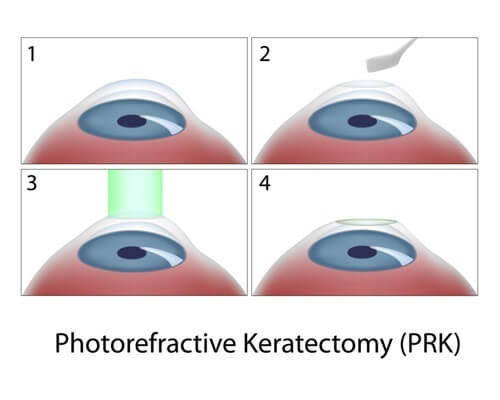LASIK PRK
INTRODUCTION
LASIK has become the treatment of choice for most people, but for individuals whose eye orbits are too deep or whose cornea is too flat, steep or thin, PRK may be the best alternative.
HOW IT WORKS
SURGICAL PROCEDURE
PRK eye surgery generally requires about twenty minutes of operating room time, but the actual duration may vary according to the type and amount of correction needed. A mild sedative, such as Valium or Ativan, may be given to help you relax. Eye drops will be administered to numb your eyes. You will be lying on the laser bed and your eyelids will be held open with a device called a lid speculum. You will be asked to focus on a special fixation light in a microscope. For a more detailed explanation see: LASIK surgery.

After PRK eye surgery, Dr. Seibel will place a soft contact lens on the cornea to protect the eye and reduce discomfort while healing. Until the contact lens is removed, your vision will be blurred. The blurriness may go away within a short time or your vision may be that way for a number of months. You will be required to use medicated and lubricating eye drops to assist the healing process. It will generally take a few weeks for your vision to stabilize.
RECOVERY
You will be able to go home afterwards, but you will need to arrange for someone to drive you and bring you back the next day for your exam. Thereafter you should not drive until Dr. Seibel has given you the go ahead.
For the first few days afterwards, you may experience discomfort, ranging from scratchiness, to actual pain; your vision may be blurry and/or may fluctuate between being clear and being blurry. In some cases, a patient’s vision improves immediately afterwards, but later becomes blurry. These conditions affect patients differently. While they may not bother some, other patients may not be able to tolerate the discomfort or lack of visual acuity, even on a temporary basis.
Functional vision typically recovers shortly thereafter. Several weeks or months may be required to attain final visual results.
RESULT
The final outcomes of PRK eye surgery or LASIK eye surgery are often identical, especially in lower power corrections; the main difference is the healing time (for more information see LASIK).
You may need glasses or other corrective lenses after the procedure on a temporary or permanent basis. PRK eye surgery will not prevent presbyopia, and may reveal a need for reading glasses, particularly for patients over forty years of age.
RISKS
PRK includes the same risks as LASIK, plus patient discomfort caused by the removal of the protective epithelium, or skin, of the cornea. This sometimes persists for 2 to 3 days until the epithelium grows back, during which time you wear a protective contact lens and use pain relief medication. PRK is also associated with some problems of regression of effect as well as haze in the stroma, both more common in higher powers of correction.
The transient haze in the cornea, sometimes associated with PRK, typically is subtle and usually does not affect vision. Occasionally this haze is significant enough to slightly reduce vision, usually resolving itself within six months. This is more common with higher degrees of correction and in individuals who have an underlying tendency to develop more aggressive scarring.
COMPARED TO LASIK
PRK has the advantage of not requiring a flap to be created or healed and is sometimes the better procedure for individuals who have thin corneas.
LASIK appears also to have advantages over PRK in the treatment of myopia greater than -4.00 diopters. LASIK appears to minimize the tendency to develop corneal haze, a form of scarring that can sometimes be seen with PRK in higher degrees of correction.
The advantages of LASIK over PRK, stated in the scientific literature and observed clinically, include:
- Less post-operative discomfort (usually a few hours compared to 2-3 days)
- Quicker visual recovery (usually 1-2 days for the majority of vision compared to 4- 10 days)
- Fewer post-operative visits (usually 4 compared to 6)
- Fewer medications (usually eye drops for 1 week compared to 3 months)
- Lower incidence of corneal haze (rarely seen compared to occasionally seen)
- No need typically for bandage contact lens (unlike PRK where a contact lens is routinely worn for 3 days)
- Wider range of correctable prescriptions (compared to limited range)
- Easier to undergo procedure on both eyes the same day.